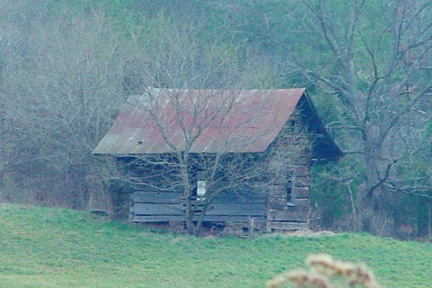Stokely Huddleston, First Tennessean To Die in the Civil War
by Richard W. Pierce, for a reprint of the book, Gone but Not Quite Forgotten
Stokely H. Huddleston was the oldest son of Willis and Kizzie Hill Huddleston (and nephew of Capt. Creed Huddleston and served under him as a Sergeant in the Mexican War) born 1819 in Overton County, Tennessee. He was married about 1842 to Mary Travis daughter of William and Mary Crockett Travis.
Stokely H. Huddleston was a soldier in two wars. He was a Sgt. Co “K” 14th US INFANTRY May 1847-Aug. 1848 during the Mexican War. He was one of the few survivors of the Mexican War. After the vote on secession Governor Harris of Tennessee commissioned him 3rd June 1861 a Colonel of the 48th Regiment of the State Militia.
According to Patriots and Guerillas of East Tennessee and Kentucky by J. A. Brents, printed in 1863:
He immediately organized the militia, with the design of persecuting the Union citizens of Overton County. He was a terror to them, as they knew his violent temper and bad habits.
Other events were occurring in the area soon after he organized the militia, of which, I am sure the militia was involved in. According to writings of Dr. Johnathan Hale of which Mr. Alan Rumrill sent me some excerpts:
On the 4th day of July 1861, near a thousand men, women and children, of Overton and Fentress Counties, Tennessee, met at Hale’s Mill, and celebrated the day, as had been the custom in former years. They raised a hickory pole, on which was hoisted the old flag. Dr. Hale’s daughters and their teacher, sang the Star Spangled Banner. Mrs. Hale read the Declaration of Independence, and the whole concourse of people partook of a bountiful repast prepared by our women, every one of whom opposed revolution in every shape.
This was considered an act of gross treason by the Tennessee, and confederate State authorities, and a force of confederate troops [this must have been the State Militia because Confederate companies were not organized in the area until late July early August] were at once stationed at the three forks of Wolf River in Fentress County, to capture or kill the leaders. On learning that a considerable part of this force was in the vicinity of the Mills; a council was held, when it was determined that Dr. Hale should go north for aid.
Mrs. Hale refused to remain, and the whole family, white and black, crossed the state line into Kentucky. They were accompanied by a few neighbors, who returned to Tennessee, and removed their families.
Continuing with story from Patriots and Guerillas of East Tennessee and Kentucky:
Elam E. Huddleston, a cousin [third cousin] of the Colonel [Stokely Huddleston], was a firm and decided Union man, and had considerable influence. He was therefore threatened and persecuted, for no Union man of any influence was permitted to remain in the State. He and his family made their escape to Kentucky.

Elam Huddleston Cabin from TheBorderlands.org (via the Internet Archive)
In a letter dated 12 July 1861 from Thomas E. Bramlett to Mrs. Hale we learn—
Dr. Hale reached here [Columbia, Kentucky] safely last evening, and left this morning for Louisville [KY].
Back to Patriots and Guerillas of East Tennessee and Kentucky:
Upon his return for his [Elam E. Huddleston] personal property, he found that the Colonel had seized it and locked it up… With the assistance of James Ferguson…, and some of the Huddlestons and Zackarys, he proceeded to his farm and broke the locks, loaded a wagon with a portion of his house and kitchen furniture, and started for Kentucky. They soon discovered that they were closely pursued by Colonel Huddleston and a company of his forces. Elam told the driver to proceed to the Kentucky line without delay, while he and his comrades selected a position for defence. He [Stokely] dashed ahead of his company, waving his sword, and demanded that Elam and his comrades should surrender. They told him they would never surrender, and warned him not to approach nearer. He did not heed them, but rushed forward, and at the keen crack of a rifle fell from his horse: Marion Zackary had fired the fatal shot. Colonel Huddleston’s followers fled, and Elam and his comrades proceeded to Kentucky without further molestation. This occurrence created great excitement. It was the first blood that had been shed in that section since the war commenced. A prominent secessionist had been killed, and Union blood must atone for it. A general persecution commenced; vengeance was threatened against all Union men, and they fled to Kentucky for safety.
We feel certain that this killing took place no later than the 27th July 1861, because the Confederate companies began organizing in this area around late July 1861 and the name of Stokely H. Huddleston is not included in any of these companies. If Stokely H. Huddleston had still been alive there is no doubt but what he would not have been involved in organizing Confederate companies. We have always heard from oral tradition that Stokely Huddleston was killed near the present Huddleston lane.
Several years ago Mrs. Bernice Huddleston, widow of first County Historian, allowed me to browse thru Mr. Tim Huddleston’s personal papers and in these papers Tim had written that Colonel Stokely H. Huddleston was buried in an unmarked grave at the Parris-Riley Cemetery. Mrs. Stokely Huddleston remarried Lewis F. Glass, progenitor of Pickett County Glass family, and moved to Barren and Metcalfe Counties, Kentucky.
References:
- History of Pickett County, Tennessee by Tim Huddleston
- Mexican War Record of Stokely H. Huddleston
- State Militia Record Commission Book
- Patriots and Guerillas of East Tennessee and Kentucky
- Excerpts from Writings of Dr. Jonathan Hale furnished by Alan Rumrill
- Letter from Thomas E. Bramlett to Mrs. Hale furnished by Alan Rumrill
Source: http://www.theborderlands.org/Stokely.htm (via the Internet Archive)
